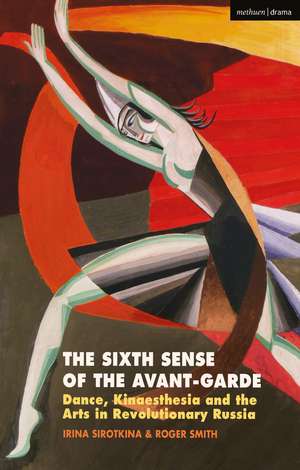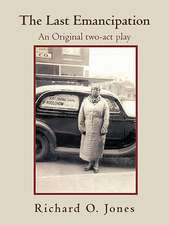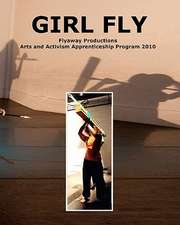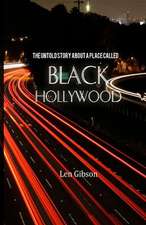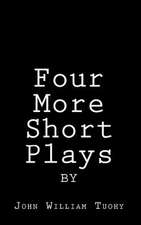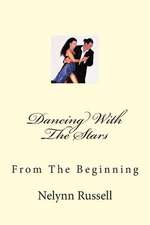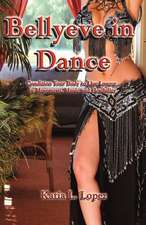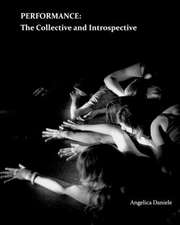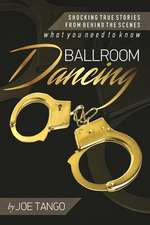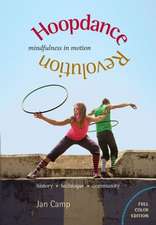The Sixth Sense of the Avant-Garde: Dance, Kinaesthesia and the Arts in Revolutionary Russia
Autor Irina Sirotkina, Roger Smithen Limba Engleză Paperback – 12 dec 2018
| Toate formatele și edițiile | Preț | Express |
|---|---|---|
| Paperback (1) | 170.95 lei 6-8 săpt. | |
| Bloomsbury Publishing – 12 dec 2018 | 170.95 lei 6-8 săpt. | |
| Hardback (1) | 567.25 lei 6-8 săpt. | |
| Bloomsbury Publishing – 19 apr 2017 | 567.25 lei 6-8 săpt. |
Preț: 170.95 lei
Preț vechi: 211.00 lei
-19% Nou
Puncte Express: 256
Preț estimativ în valută:
32.71€ • 34.98$ • 27.27£
32.71€ • 34.98$ • 27.27£
Carte tipărită la comandă
Livrare economică 17 aprilie-01 mai
Preluare comenzi: 021 569.72.76
Specificații
ISBN-13: 9781350087408
ISBN-10: 1350087408
Pagini: 232
Ilustrații: 15 bw illus
Dimensiuni: 138 x 216 x 17 mm
Greutate: 0.27 kg
Editura: Bloomsbury Publishing
Colecția Methuen Drama
Locul publicării:London, United Kingdom
ISBN-10: 1350087408
Pagini: 232
Ilustrații: 15 bw illus
Dimensiuni: 138 x 216 x 17 mm
Greutate: 0.27 kg
Editura: Bloomsbury Publishing
Colecția Methuen Drama
Locul publicării:London, United Kingdom
Caracteristici
It shows how dance had a central role in shaping other arts practices and contributed to the state of knowledge at that time, with implications for the present
Notă biografică
Irina Sirotkina is a lecturer at the Institute for the Theory and History of the Humanities, The Research University - Higher School of Economics, Moscow, Russian Federation. She is a cultural historian who has published on the history of psychiatry and on the history of free dance.Roger Smith is Emeritus Reader in the History of Science, Lancaster University, UK and Associate Fellow at the Institute of Philosophy of the Russian Academy of Sciences, Moscow, Russian Federation. He is an internationally well known historian and philosopher of psychology and the human sciences, the author of standard texts in the field as well as specialist studies relating to the history of mind and brain and the understanding of 'being human', including Inhibition: History and Meaning in the Sciences of Mind and Brain (1992), and The Norton History of the Human Sciences (1997).
Cuprins
List of illustrationsPrefaceAcknowledgementsNote on text/translationList of abbreviations Introduction: Movement and exuberant modernismChapter 1 The sixth sense The senses Muscular feeling and kinaesthesia Chapter 2 Search for deeper knowledgeThe kinaesthetic intellect'The higher sensitivity' Kinaesthesia and synaesthesiaChapter 3 Expression in dance The new dance The Russian Hellenes 'Ach, the devil take it, they're dancing here again'Chapter 4 Speaking movement The perfect language: Andrei Bely on gesture The dance-word: the creative union of Esenin and DuncanWord plasticity: the budetliane and the bare-footed Chapter 5 By 'the fourth way' The mystic arts From Dalcroze to Gurdjieff 'Presence' Chapter 6 Thinking with the body Mayakovsky dances the fox-trot Brik-dance Who thought up biomechanics? Chapter 7 Art as bodily knowledge Technique Kinaesthesia in cultureFurther readingNotesIndex
Recenzii
What makes The Sixth Sense of the Avant-Garde an invaluable scholarly contribution is the persuasive and ambitious argument that the authors, Irina Sirotkina and Roger Smith, present in the book - an argument that extends well beyond literary and artistic studies of modernist practices. Specifically, they seek to reassess longstanding notions on the senses of perception . [The book] provides an interesting perspective on avant-garde art, offering a wide-ranging overview of the ideas that preoccupied intellectuals at that time. As such, it can be of interest to scholars of various backgrounds. Furthermore, while the authors try to redefine and even dismantle some of the stable categories and bring attention to a concept of the 'knowing body,' they also keep the content lively and engaging for their readers throughout the entire work.
This book is a treasure chest of personages and practices-everyone from Kandinsky to Blok, from Scriabin to Shklovsky, and multiple souls in between; everything from Dalcroze Eurythmics to the Foxtrot. It offers dynamic new ways to view the cultural history of this time. It all but exhorts its readers to go out and dance themselves. Many sources were crunched to make this book's chapters, and many exciting roads lead out of them into future projects.
This volume examines kinesthesia-the sense of movement-as a foundation of personal knowledge and cultural innovation, claiming primacy of kinesthesia over the other senses in that it affords unmediated contact with the world... The extensive notes and suggestions for further reading compensate and make the book invaluable. Summing Up: Recommended.
This book is a treasure chest of personages and practices-everyone from Kandinsky to Blok, from Scriabin to Shklovsky, and multiple souls in between; everything from Dalcroze Eurythmics to the Foxtrot. It offers dynamic new ways to view the cultural history of this time. It all but exhorts its readers to go out and dance themselves. Many sources were crunched to make this book's chapters, and many exciting roads lead out of them into future projects.
This volume examines kinesthesia-the sense of movement-as a foundation of personal knowledge and cultural innovation, claiming primacy of kinesthesia over the other senses in that it affords unmediated contact with the world... The extensive notes and suggestions for further reading compensate and make the book invaluable. Summing Up: Recommended.
